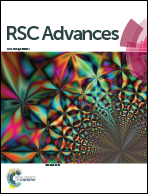Synthesis, photophysical and electrochemical studies of acridone-amine based donor–acceptors for hole transport materials†
Abstract
A series of new donor–acceptor molecules based on acridone-amine containing four aryl substituted 2,7-diaminoacridones (1–4) and morpholine substituted acridone compounds (5) were synthesized in good yields using palladium catalysed Buchwald–Hartwig C–N amination. Their absorption, photoluminescence and electrochemical properties were investigated in solution and in thin films. Photophysical properties were found to be affected by the electron donating capability of the substituents on the diaryl amines. Absorption showed intramolecular charge transfer transitions (ICT) in a range of 447–479 nm. These acridone amine derivatives emit in the green region (500–527 nm). Reversible oxidation waves were observed for compounds 1–5 in cyclic voltammetry. The HOMO (−4.95 to −5.11 eV) and LUMO (−2.36 to −2.56 eV) energy levels of 1–5 were calculated. The EHOMO for compounds 1–5 are similar with the most widely used hole transporting materials NPD, TPD and spiro-OMe-TAD. Hence we believe that these compounds have the potential to be used as hole transporting materials in optoelectronic devices.


 Please wait while we load your content...
Please wait while we load your content...